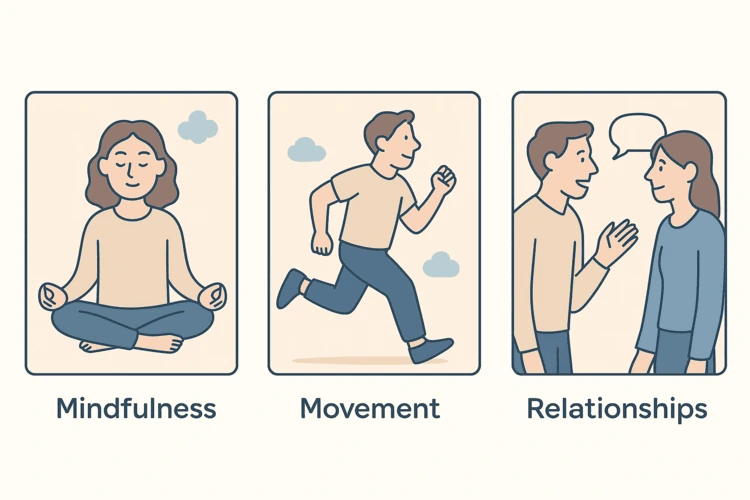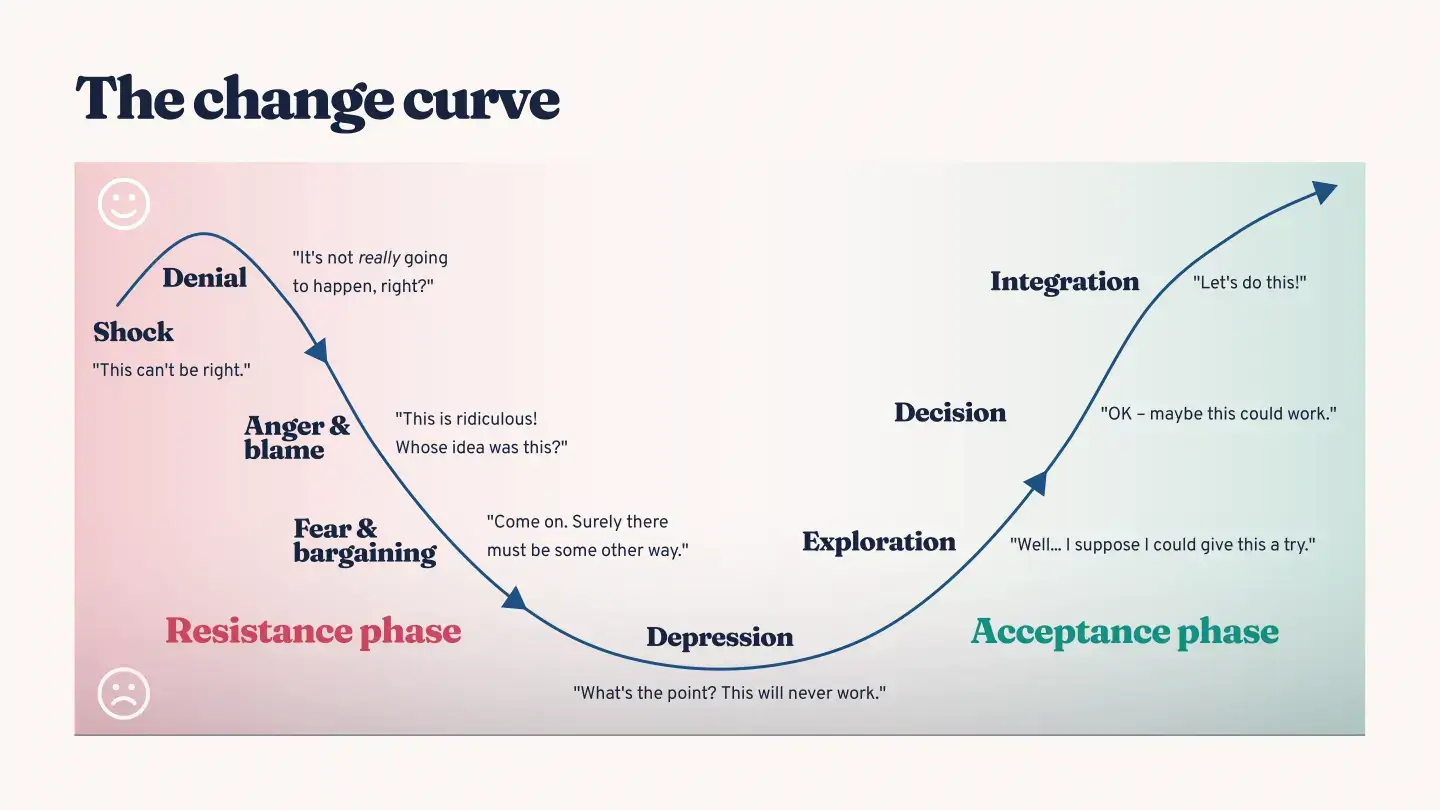CAREER & BUSINESS
Master Change Management
for Personal & Career Success
Turn uncertainty into opportunity: Discover practical strategies to confidently navigate personal and professional change management.
Practical strategies to confidently navigate
personal and professional change
“Everything changes and nothing remains still.”
Heraclitus said that around 2,500 years ago, yet it feels truer today than ever. Change isn’t just inevitable; it’s happening constantly: new jobs, new cities, new roles, even new family members. And yet, despite how common change is, mastering it feels incredibly challenging.
Let’s break it down.
“Everything changes and nothing remains still.”
What Is Personal Change Management?
Personal change management isn’t some abstract concept. It’s just a practical way of adapting your mindset and actions so you can confidently handle whatever life throws your way at home and at work, without stress.
Change, though challenging, presents enormous opportunities. It invites us to grow, adapt, and expand our comfort zones. Each time you successfully navigate a significant shift at work or in your life, you build greater self-confidence and resilience.
Whether you’re dealing with a new professional role, adjusting to life as an expat in Switzerland, or dealing with personal challenges, effective change management skills provide a foundation of lasting career success and personal fulfillment.

Why Does Change Feel So Difficult?
Understanding our brain’s resistance to change
Well, to put it simply, our brains aren’t exactly fans of change. They’re wired to keep things predictable and consistent. Your brain likes routine because routine feels safe and doesn’t waste precious energy. Change throws all that comfort out the window, provoking feelings of insecurity, anxiety, fear, or even frustration.
When you understand how your brain resists change, you’re better equipped to manage your negative emotions. It becomes easier to accept these reactions as normal, and overcome them effectively.
The Kübler-Ross Change Curve
Source: BiteSize Learning – “Change Curve Management Model”
When we face major life or work changes, it’s completely normal to experience a wave of emotions. That emotional rollercoaster is exactly what the Kübler-Ross Change Curve illustrates clearly. Originally developed by Elisabeth Kübler-Ross to explain how people cope with grief, this curve helps us understand and anticipate our emotional reactions during any significant change.
At first, you’ll likely find yourself in denial. You know that feeling—the initial shock, the disbelief: “Is this really happening?” This is your brain’s way of protecting you from sudden overwhelm. Soon after comes the resistance phase, often marked by frustration, stress, anxiety, or even anger. You might feel stuck, resentful, or worried about losing what’s familiar and comfortable: “Why me? Why now?”
But here’s the good news: after this challenging dip comes the exploration stage. This is where things start looking up. You begin to accept the change, cautiously exploring new possibilities, and experimenting with new ways of thinking or acting. Optimism slowly replaces anxiety. Finally, you reach commitment, where you fully embrace the new situation and feel confident and comfortable again.
Understanding these emotional phases helps you navigate your own feelings and be more kind and patient with yourself or your team. By clearly identifying where you currently stand on this curve, you’ll feel less alone, more in control, and better equipped to confidently move forward.
So, in which stage are you right now?
A Personal Example: Navigating Change Abroad
Take my own experience.
I moved from France to the USA, to the Netherlands, to Switzerland, and who knows what’s next. And every time I moved countries to start a new job and a new life, I was excited; but deep down, I also felt lingering anxiety. Everything from learning a new language, navigating unfamiliar environments, to figuring out local customs was overwhelming.
It wasn’t until I understood how personal change management works that things finally start to fall into place.
Are you ready to turn your next change into an opportunity to thrive?
4 Success Strategies to Master Change Management
Here are four clear, practical strategies to help you confidently manage change:
1. Clarify Your Purpose: Discover Your “Why”
This isn’t just about goal setting. It’s deeper.
It’s about finding out exactly why you’re making a change, the real reason beneath the surface, the one that gives you goosebumps. For instance, let’s say you want to lose weight. It’s easy to say, “I want to lose 10 kilos”, but that’s not motivating enough when things get challenging.
One client once shared she wanted to lose weight.
But when we dug deeper, her real “why” was different: she wanted to stay healthy enough to travel the world with her daughter once she becomes a teenager. Now, that’s powerful motivation!
Knowing your deeper reason gives you the strength to push through setbacks.
2. Break Down Your Goals into Small, Achievable Steps
Big goals are great, but they’re also intimidating. Instead, break your big change into tiny, manageable pieces.
If your goal is to start rock climbing, your first step isn’t climbing a mountain; it might simply be booking a beginner class or buying some gear.
When I transitioned from being an employed project manager in the corporate world to becoming an independent life and career coach, it initially felt daunting. So, I took smaller steps: hiring a coach, researching credentials, understanding business structures, confronting my fears, and choosing a company name. Each minor achievement gradually built my confidence. Suddenly, this huge, scary change became an exciting adventure.
Developing your own roadmap through change empowers you to regain control. Make sure to break the process into exciting SMART goals: Goals that are Specific, Measurable, Achievable, Relevant, and Time-bound.
3. Anticipate Obstacles and Prepare Effective Solutions
Change is rarely smooth sailing. You’ll face setbacks, it’s natural. Instead of ignoring these obstacles, actively think through them beforehand. Ask yourself clearly:
- “What might stop me from progressing?”
- “What will be my biggest challenge?”
A client kept on complaining he couldn’t get himself to exercise, despite it being crucial for his health. We figured out his issue: without anyone holding him accountable, he easily skipped his routine. So, we prepared proactive solutions: he hired a workout coach and treated his scheduled workouts like critical meetings in his calendar.
Anticipating setbacks doesn’t mean you’re negative, it’s smart and strategic preparation.

Build a Strong & Positive Mind with Emotional Resilience
Emotional resilience is your ability to bounce back from stress, challenges, or changes with confidence and positivity. Resilient professionals don’t merely endure change; they leverage it for personal growth.
Here are practical resilience exercises you can try even as a busy professional:
-
- Mindfulness: Even five-minute daily mindfulness exercises significantly reduce stress and enhance emotional regulation.
- Physical Activity: Regular movement, even just lunchtime walks along Basel’s Rhine, clears your mind and boosts resilience.
- Strengthening Social Connections: Invest in relationships at work and home, especially valuable for expats building new networks. Strong connections, and obviously laughter, provide essential emotional support.
4. Track Your Progress and Celebrate Each Success
“What gets measured gets improved.” – Peter Drucker
Regularly remind yourself how far you’ve come, and not just what’s left to achieve. Celebrate even small victories to generate positive reinforcement and maintain motivation until you’ve reached your ultimate goal.
It doesn’t have to be anything fancy or expensive, even a simple inner smile and a “Well done me!” will do the trick.
FAQ
How can I manage stress when facing changes at work?
Effectively managing stress during workplace changes involves acknowledging your negative emotions, clarifying exactly what’s changing, creating a supportive personal plan, and practicing daily resilience strategies like mindfulness or physical activity.
Why is emotional resilience important in change management?
Emotional resilience helps you handle stress and frustration constructively, maintain productivity, sustain positivity, and successfully navigate career and personal transitions.
Your Action Plan to Thrive Through Change
Ready to apply these strategies & master change management?
Here’s my challenge to you:
1. Your Change
First, pick one specific area in your life or career you’d like to change right now. Maybe building healthier habits, or getting a promotion at work?
2. Your Purpose
Now, ask yourself honestly, “Why is this really important to me?” Dig deep. This will be your direction, your personal “North Star”.
3. Your Action Plan
Once you’re clear on where you’re headed, identify a tiny, easy first step you can complete immediately and that will move you forward. “What’s one thing I could do within the next 5 minutes?”
4. Your Obstacles
Then, reflect on your biggest challenges that might come in the way: “What excuses am I likely to make?”, “What fears am I likely to have?” If you know what will hit you, you can train how you’ll overcome it.
5. Your Success
Finally, define precisely how you will measure your success: “How will I know I have achieved my goal?” Then, create a clear plan to monitor your daily progress, ideally with a Yes-or-No answer.
That’s it! Be ready to celebrate your success and this new you.
Change doesn’t have to be overwhelming. With the right strategies, you can turn uncertainty into opportunity and stress into excitement.
Yes, you already have what it takes to become a master of change. But if you’d like personalized support or a little accountability to reach your goals faster (and with more fun!), I’m here for you.
Reach out, book a free consultation call, and let’s get started together. You’ve got this!
What are you waiting for ?
Make the choice your leaders & talents will thank you for !
← Back to Growth & Success at Work


